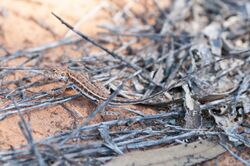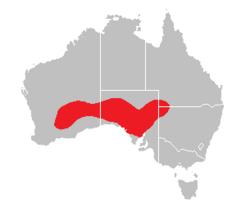Biology:Mallee military dragon
| Mallee military dragon | |
|---|---|

| |
| Scientific classification | |
| Domain: | Eukaryota |
| Kingdom: | Animalia |
| Phylum: | Chordata |
| Class: | Reptilia |
| Order: | Squamata |
| Suborder: | Iguania |
| Family: | Agamidae |
| Genus: | Ctenophorus |
| Species: | C. fordi
|
| Binomial name | |
| Ctenophorus fordi (Storr, 1965)[1]
| |

| |
| Distribution of Ctenophorus fordi | |
| Synonyms[1][2] | |
| |
The Mallee military dragon[3] (Ctenophorus fordi), also commonly known as the Mallee dragon and the Mallee sand-dragon,[2] is a species of lizard in the family Agamidae. The species is native to the arid parts of southern Australia .[1][3]
Etymology
The Mallee military dragon's specific name, fordi, commemorates Dr. Julian Ralph Ford (1932–1987). Dr. Ford was an ornithologist, herpetologist and chemist who worked at the Western Australian Museum. He collected the lizard holotype and many of the paratypes.[2][4]
Description
C. fordi is a small endemic Australian lizard that grows to a maximum size of 5 cm (2.0 in) snout–vent length (SVL).[5] C. fordi displays a dark reddish-orange colouration with a pale dorso-lateral stripe extending from the posterior region of the neck to the anterior portion of the tail.[5] The pale stripe is bordered by a thin, black stripe.[5] The dark orange-brown region enclosed by the pale stripe is flecked with small pale spots.[5]
Geographic range
C. fordi is found in south-eastern Western Australia, through central South Australia, and into the north-west corner of New South Wales and south-west corner of Queensland.[5][6] What were previously considered to be populations occurring in south-east South Australia, western Victoria and central New South Wales,[5] were reclassified in 2019 as a separate species; the Eastern Mallee dragon.[6]
Habitat
The main habitat type for the Mallee military dragon includes shrubs and hummock grass.[2] The Mallee dragon lives in sandy arid to semi-arid areas of Mallee woodland and spinifex, as well as vegetated sand dunes.[7][8] It prefers areas of Mallee that haven't been burnt for around 30 years, when spinifex cover is at its maximum.[9]
Behaviour
Mallee military dragons emerge from dormancy in August, males appear about four weeks earlier than females.[10] Active even on very hot days, they forage in sandy, open areas, and will dash for cover into nearby grasses or low bushes if disturbed or pursued.[11][7][10] Males are territorial.[10]
The signaling behaviour of C. fordi is composed almost exclusively of head bobs, which both males and females produce when they encounter another individual.[12]
Diet
The Mallee military dragon's diet largely consists of ants.[13][14]
Reproduction
The Mallee military dragon reproduces sexually, with an oviparous and dioecious reproduction method.[15] Mating occurs in spring. Females produces sequential clutches of two to five eggs over the reproductive season and the offspring hatch from December to March.[15] Males are not territorial and there has been no evidence of male-male aggression.[15]
Conservation actions
The species C. fordi is listed under the IUCN Red List of Threatened Species as a species of "Least Concern".[1] The Mallee military dragon occurs in several protected areas, including the Sturt National Park in New South Wales, and the Currawinya National Park in Queensland.[3][6]
Threats
The Mallee military dragon is vulnerable to various threats.[16] These include:
- Habitat loss from land clearing, degradation by introduced species such as cattle and rabbits, and modification caused by climate change[16]
- Death on roads[16]
- Predation by introduced species such as dogs, cats, pigs, and foxes[16]
- Threats from emerging diseases[16]
References
- ↑ 1.0 1.1 1.2 1.3 Cite error: Invalid
<ref>tag; no text was provided for refs namediucn status 19 November 2021 - ↑ 2.0 2.1 2.2 2.3 Ctenophorus fordi at the Reptarium.cz Reptile Database. Accessed 19 May 2018.
- ↑ 3.0 3.1 3.2 "Ctenophorus fordi (Storr, 1965)". Atlas of Living Australia. https://bie.ala.org.au/species/urn:lsid:biodiversity.org.au:afd.taxon:e6786f89-b190-4d42-a49e-1c215b68fb4b#overview.
- ↑ Beolens, Bo; Watkins, Michael; Grayson, Michael (2011). The Eponym Dictionary of Reptiles. Baltimore: Johns Hopkins University Press. xiii + 296 pp. ISBN:978-1-4214-0135-5. (Ctenophorus fordi, p. 92).
- ↑ 5.0 5.1 5.2 5.3 5.4 5.5 Garcia JRD, Dyer A (2013). "Trade-off between camouflage and sexual dimorphism revealed by UV digital imaging: the case of Australian Mallee dragons (Ctenophorus fordi)". Journal of Experimental Biology 216: 4290-4298. https://doi.org/:10.1242/jeb.094045
- ↑ 6.0 6.1 6.2 Sadlier, R.A.; Colgan, D.; Beatson, C.A.; Cogger, H.G. (2019). "Ctenophorus spinodomus sp. nov., a New Species of Dragon Lizard (Squamata: Agamidae) from Triodia Mallee Habitat of Southeast Australia". Records of the Australian Museum 71 (5): 199–215. doi:10.3853/j.2201-4349.71.2019.1700.
- ↑ 7.0 7.1 Swan G, Shea G, Sadlier R (2004) A Field Guide to Reptiles of New South Wales, Reed New Holland, Sydney, New South Wales, ISBN:187706906X
- ↑ Pianka ER (1972). "Zoogeography and speciation of Australian desert lizards: an ecological perspective". Copeia 1972 (1): 127–145. doi:10.2307/1442789.
- ↑ Nimmo, D.G.; Kelly, L.T.; Spence-Bailey, L.M.; Watson, S.J.; Taylor, R.S.; Clarke, M.F.; Bennet, A.F. (2013). "Fire Mosaics and Reptile Conservation in a Fire‐Prone Region". Conservation Biology 27 (2): 345–353. doi:10.1111/j.1523-1739.2012.01958.x. PMID 23163245.
- ↑ 10.0 10.1 10.2 Swan, M., Watharow, S. (2005) Snakes, Lizards and Frogs of the Victorian Mallee, CSIRO Publishing, Collingwood, Victoria, Australia ISBN:0643091343
- ↑ Wilson S, Swan G (2013). A Complete Guide to Reptiles of Australia, Fourth Edition. Sydney: New Holland Publishers. 522 pp. ISBN:9781921517280
- ↑ Ramos JPR (2017). "Quantifying Ecological Constraints on Motion Signaling". Ecology and Evolution 5: 1–14.
- ↑ Cogger H (2000). Reptiles and Amphibians of Australia, Sixth Edition. Sydney: Reed New Holland. 808 pp. ISBN:1876334339. (Ctenophorus fordi, p. 315).
- ↑ Abensperg-Traun, Max; Steven, Dion (1997). "Ant‐and termite‐eating in Australian mammals and lizards: a comparison". Australian Ecology 22 (1): 9–17. doi:10.1111/j.1442-9993.1997.tb00637.x.
- ↑ 15.0 15.1 15.2 "Mallee Dragon". National Museum of Natural History. https://eol.org/pages/795263.
- ↑ 16.0 16.1 16.2 16.3 16.4 "Mallee military dragon". Stewart Macdonald. http://www.arod.com.au/arod/reptilia/Squamata/Agamidae/Ctenophorus/fordi.
Further reading
- Cogger HG (2014). Reptiles and Amphibians of Australia, Seventh Edition. Clayton, Victoria, Australia: CSIRO Publishing. xxx + 1,033 pp. ISBN:9780643100350.
- Manthey U, Schuster N (1999). Agamen, Zweite Ausgabe [= Agamas, Second Edition ]. Münster: Natur und Tier Verlag. 120 pp. (Ctenophorus fordi, new combination, p. 48). (in German).
- Sadlier RA, Shea GM (1989). "The reptiles of Mungo National Park and the Willandra Lakes region". Herpetofauna 19 (2): 9–27.
- Storr GM (1965). "The Amphibolurus maculatus species-group (Lacertilia: Agamidae) in Western Australia". Journal of the Royal Society of Western Australia 48: 45–54. (Amphibolurus fordi, new species).
- Wells RW, Wellington CR (1985). "A Classification of the Amphibia and Reptilia of Australia". Australian Journal of Herpetology, Supplemental Series (1): 1–61. (Phthanodon fordi, new combination, p. 18; Phthanodon hawkeswoodi, new species, p. 18).
Wikidata ☰ Q3006457 entry
 |


